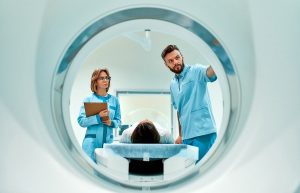In a setback to a national vaccination campaign that was finally gaining ground, the federal government said Thursday that Johnson & Johnson will allocate 86 percent fewer doses of its coronavirus vaccine across the United States next week.
The company delivered the first batch of its single-dose vaccine at the beginning of March, sending 2.8 million doses across the country before dipping below 400,000 in the following weeks, The New York Times reported. Last week, about 1.9 million doses were sent across the country, and this week 4.9 million shots went out. Next week, that number will drop to 700,000.
Federal administrators divide vaccine doses nationwide based on each state’s adult population. That means that California will bear the brunt of the reduction: After receiving 572,700 doses of the vaccine this week, it will get only 67,600 doses of the J&J shot next week, the Times reported.
In Texas, the allocation will drop to 46,300 from 392,100. Florida, which received 313,200 shots this week, will get 37,000 next week, the newspaper said.
The slowdown comes days after federal officials learned that Emergent BioSolutions, a contract manufacturer that has been making both the Johnson & Johnson and the AstraZeneca vaccines in a Baltimore plant, had mixed up ingredients from the two and ruined up to 15 million doses of the Johnson & Johnson vaccine.
How big a role that problem has played in Johnson & Johnson distribution woes is hard to determine, the Times said.
Distribution hasn’t been Johnson & Johnson’s only problem this week: North Carolina health officials said Thursday that they stopped administering Johnson & Johnson vaccine doses at a mass immunization site in Raleigh and at clinics in Hillsborough and Chapel Hill after at least 26 people experienced adverse reactions, including fainting, the Associated Press reported. Four people were taken to hospitals for further examination, and state and federal health officials are reviewing the matter.
Kristen Nordlund, spokeswoman for the U.S. Centers for Disease Control and Prevention, told the AP that it is aware of adverse reactions in some people who received the vaccine shots in Iowa, Colorado, Georgia and North Carolina. Those reactions include dizziness, lightheadedness, feeling faint and rapid breathing.
Nordlund said the CDC is working with state and local officials to evaluate the problem and has performed vaccine lot analyses and found no cause for concern. The CDC is not telling health departments to stop vaccinations, the AP noted.
As for the nation’s overall vaccination effort, the CDC reported Friday that about 112 million Americans have received at least one dose of a vaccine, including about 66.2 million people who have been fully vaccinated.
COVID cases climb in Midwest as British variant takes hold
As new coronavirus cases soared across the Upper Midwest on Wednesday, a top health official said that a highly infectious variant first discovered in Britain has now become the most common source of infections in this country.
“Based on our most recent estimates from CDC surveillance, the B.1.1.7 variant is now the most common lineage circulating in the United States,” CDC Director Dr. Rochelle Walensky said during a White House media briefing. There are now 19,554 confirmed cases of the B.1.1.7 variant in the United States, according to the CDC.
Scientists and federal health officials have warned repeatedly that a fourth wave of coronavirus cases could arise in the United States this spring because of the emergence of more contagious variants and the easing of social distancing measures.
In the Upper Midwest, Michigan has been slammed: New cases and hospitalizations there have more than doubled in the last two weeks, and the six metro areas in the United States with the greatest number of new cases relative to their population are all in Michigan, the Times reported.
Several other states in the Upper Midwest have also reported significant increases in new infections and hospitalizations. In Illinois, the daily average for new cases has jumped about 56 percent in the past two weeks, to about 2,832 a day, the Times reported. Hospitalizations have risen about 28 percent from two weeks ago. Meanwhile, Wisconsin and North Dakota have seen their average case counts jump 50 percent or more in the last two weeks.
Nationally, new cases have stalled overall, while hospitalizations have leveled off and deaths remain near an average of about 800 a day, according to the Times. The average number of new cases had reached nearly 65,000 a day as of Tuesday, up 19 percent from two weeks ago.
The U.S. coronavirus case count passed 31 million on Friday, while the death toll passed 559,000, according to a Times tally. On Friday, the top five states for coronavirus infections were: California with nearly 3.7 million cases; Texas with over 2.8 million cases; Florida with 2.1 million cases; New York with more than 1.9 million cases; and Illinois with nearly 1.3 million cases. Worldwide, more than 134 million cases had been reported by Thursday, with over 2.9 million dead from COVID-19.
Nearly 8 in 10 school, child care workers have had first shot of COVID vaccine
In findings that bode well for the full reopening of schools across America, a new government survey shows that nearly 80 percent of school employees and child care workers have received at least one dose of a coronavirus vaccine.
Released by the U.S. Centers for Disease Control and Prevention on Tuesday, the latest figures came as the Biden administration pushes to reopen schools by the president’s 100th day in office.
In total, about 8 million teachers, school staff and child care workers said they had received their first vaccine dose by the end of March, with about 2 million receiving their shot through the Federal Retail Pharmacy Program, the CDC said in its report. In total, the agency received almost 13,000 responses from education staff and nearly 40,000 responses from child care workers.
“Our push to ensure that teachers, school staff, and child care workers were vaccinated during March has paid off and paved the way for safer in-person learning,” CDC Director Dr. Rochelle Walensky said in a statement.
Schools have already been responding to the increased vaccination efforts.
According to a school reopening tracker created by the American Enterprise Institute, only 7 percent of the more than 8,000 districts being tracked were fully remote by March 22, the lowest percentage since the tracker was started in November, the Times reported. At the same time, 41 percent of districts were offering full-time in-person instruction, the highest percentage in that same period.
On Tuesday, the American Federation of Teachers (AFT) released a survey of more than 1,700 of its members that largely mirrored the CDC results: Just over 80 percent of association members said they had been vaccinated or had made a vaccine appointment.
Federation President Randi Weingarten said in a statement that, “AFT members have embraced vaccines as vital to getting back in the classroom.”
“They want to return, the road map to reopening is robust, and if we instill trust and meet fear with facts we can finally end this national nightmare,” Weingarten added.
More information
The U.S. Centers for Disease Control and Prevention has more on the new coronavirus.
SOURCES: The New York Times; Associated Press
Source: HealthDay
Copyright © 2025 HealthDay. All rights reserved.

















